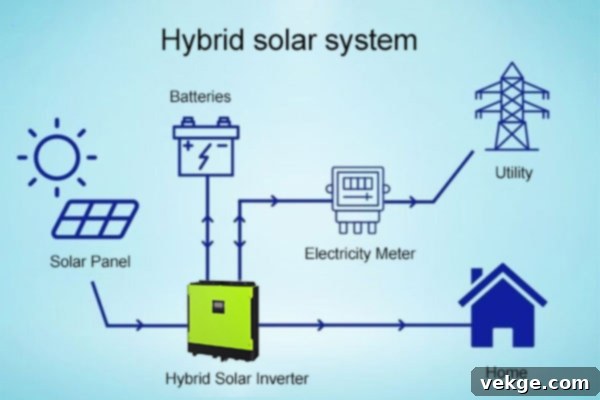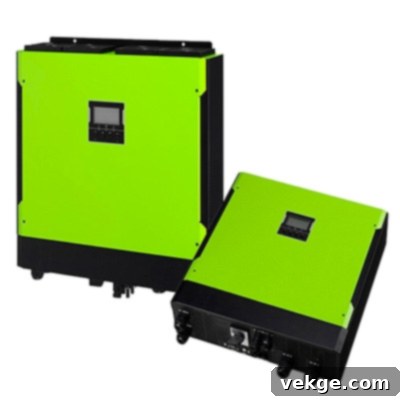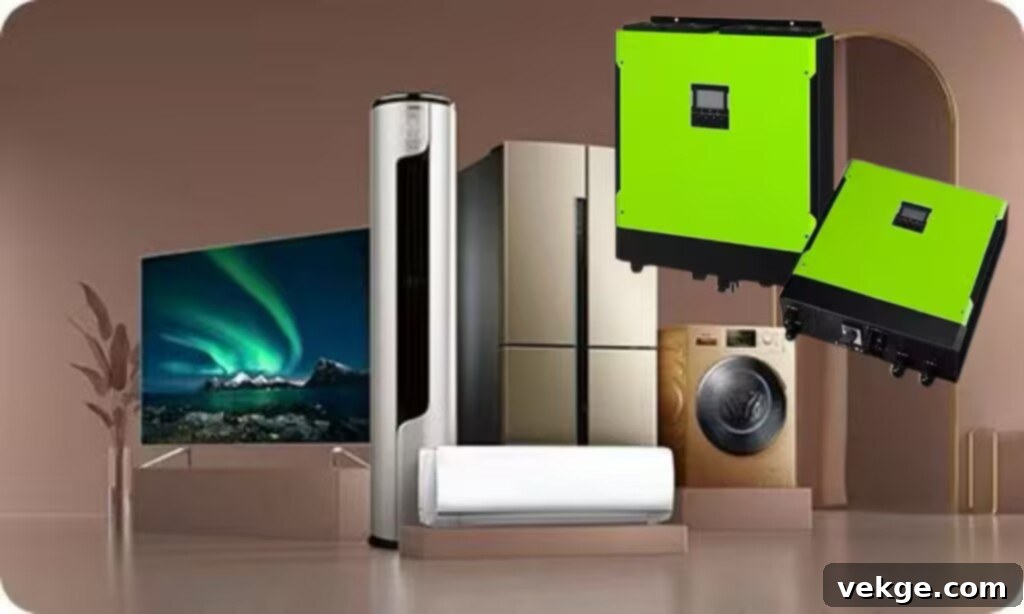Hybrid Solar Inverters: The Ultimate Guide to Smart Home Energy Management
Imagine an energy system that intelligently switches between solar power, battery storage, and the utility grid, ensuring your home or business always has power, day or night. This isn’t a futuristic concept; it’s the reality offered by a hybrid solar inverter. These advanced devices act as the central brain of your entire energy setup, seamlessly coordinating solar panels, batteries, and the grid to provide reliable, efficient, and cost-effective electricity.
For anyone seeking greater energy independence, lower electricity bills, and uninterrupted power, hybrid solar inverters present an unparalleled solution. They simplify complex energy management, making it more affordable and dependable for homes, remote cabins, bustling offices, and even larger facilities. By integrating multiple power sources into a single, cohesive system, hybrid inverters offer peace of mind and a significant step towards a sustainable future.
What is a Hybrid Solar Inverter?
A hybrid solar inverter is a sophisticated evolution of the traditional solar inverter. While a standard grid-tied inverter simply connects your solar panels to the grid (often without battery backup), and an off-grid inverter relies solely on solar and batteries, a hybrid solar inverter cleverly integrates all three: solar panels, battery storage, and the utility grid. This “best of all worlds” approach allows for unparalleled flexibility and resilience in managing your power supply.
Unlike simpler systems, a hybrid inverter makes automatic, intelligent decisions about which energy source to utilize at any given moment. During the day, it prioritizes solar energy to power your appliances and recharge your batteries. As the sun sets or weather conditions change, it seamlessly transitions to drawing power from your charged batteries. Should battery levels run low or power demands spike, the inverter can effortlessly switch to drawing supplementary power directly from the grid. This ensures that your home or facility maintains a constant and reliable power supply, minimizing reliance on the grid when solar and battery power are available.
Crucially, in the event of a grid power outage, the hybrid inverter immediately activates the stored battery power, providing instantaneous backup. This means your essential appliances continue to run without interruption, maintaining normalcy even when the rest of the neighborhood goes dark. This feature alone makes hybrid inverters an invaluable asset for residential and commercial users alike, offering both energy independence and critical power security.
How Hybrid Solar Inverters Work: A Seamless Energy Flow
The operational principle of a hybrid solar inverter is as ingenious as it is straightforward. It orchestrates a continuous and optimized flow of energy throughout the day and night, adapting to both your power demands and the availability of solar energy. Here’s a breakdown of its working procedure:
- Daytime Power Generation and Consumption: When the sun is shining, your solar panels generate electricity. The hybrid inverter directs this clean energy to power your home’s appliances directly, efficiently meeting your immediate electricity needs without drawing from the grid.
- Battery Charging: If the solar panels generate more power than your home is currently consuming, the surplus energy is intelligently diverted by the inverter to recharge your battery bank. This ensures that valuable solar energy is stored for later use, maximizing your self-consumption.
- Grid Export (Net Metering): Once your batteries are fully charged, and if your system is configured for it, any remaining surplus solar energy can be automatically fed back into the utility grid. This process, often referred to as net metering, can earn you credits or payments from your utility provider, further reducing your electricity bills and contributing to the grid’s renewable energy supply.
- Nighttime and Low-Light Operation: As evening approaches, or during periods of low sunlight, the inverter gracefully switches to drawing power from your charged batteries. This allows you to continue running your home on stored solar energy, significantly reducing your reliance on grid power during peak evening hours when electricity rates might be higher.
- Grid Backup Integration: Should the battery levels become low, or if a sudden, heavy load exceeds the battery’s output capacity, the hybrid inverter intelligently and automatically switches to drawing power from the utility grid. This seamless transition ensures your power supply remains uninterrupted.
- Automatic Blackout Protection: In the event of a complete grid failure or blackout, the hybrid inverter instantly isolates your home from the grid and switches over to battery power. This transition is so rapid (typically within milliseconds) that you often won’t even notice a flicker in your lights, providing continuous power for essential appliances and ensuring vital systems remain operational.

Key Features of Modern Hybrid Solar Inverters
Modern hybrid inverters are engineered with a suite of advanced features that contribute to their reliability, efficiency, and user-friendliness. These attributes ensure optimal performance and comfort, making them a cornerstone of contemporary energy systems. Here are some of the most critical features:
Exceptional Efficiency
Most high-quality hybrid inverters boast efficiency ratings exceeding 92%, often reaching 98% or higher. This high efficiency minimizes energy loss during conversion, ensuring that a greater percentage of the energy generated by your solar panels or stored in your batteries is actually usable. Furthermore, they typically provide a pure sine wave AC output, which is identical to grid power. This clean and stable electricity is safe and dependable for all types of appliances, including the most sensitive electronics and medical equipment, preventing potential damage and ensuring optimal performance.
Integrated MPPT Charge Controller
A Maximum Power Point Tracking (MPPT) charge controller is an essential component built into hybrid inverters. The MPPT continuously monitors and adjusts the electrical operating point of your solar panels to extract the maximum possible power from them, even under varying conditions. This means that whether it’s a bright, sunny day or a cloudy, overcast one, the MPPT ensures your panels are operating at their peak efficiency, maximizing your energy harvest and ensuring consistent energy production regardless of fluctuating sunlight due to weather changes or shading.
Wide PV Input Voltage Range
Many hybrid inverters are designed to accommodate a wide Photovoltaic (PV) input voltage range, often up to 900 V DC or even higher. This flexibility is incredibly beneficial as it allows for compatibility with a broader array of solar panel configurations and system sizes. A wide input range simplifies system design, reduces the need for complex stringing, and provides stable performance across different solar array setups, making future expansions easier and more cost-effective.
User-Friendly Monitoring Capabilities
Modern hybrid inverters are equipped with intuitive LCD screens that provide real-time information on critical parameters such as power loads, input/output voltage, battery status, and energy consumption. Beyond on-device displays, many models also offer advanced remote monitoring capabilities. Through Wi-Fi or Ethernet connectivity, users can access detailed performance data, historical trends, and system alerts via dedicated mobile apps or web portals on their smartphones or computers. This allows for convenient, real-time tracking and management of your energy system from anywhere.
Comprehensive Safety Protections
Safety is paramount in any electrical system, and hybrid inverters are built with robust, multi-layered protection features. These typically include safeguards against overloading, over-temperature conditions, short circuits, reverse polarity, and over/under voltage. These built-in protections ensure the longevity of the inverter itself, protect connected appliances, and provide essential safety for your entire energy system, mitigating potential risks and ensuring reliable operation.
Unlocking the Benefits of Hybrid Solar Inverters
The advantages of integrating a hybrid solar inverter into your energy system extend far beyond mere economic savings. They offer a holistic approach to energy management, providing robust backup power, intelligent energy optimization, and the assurance of an uninterrupted power supply. Here’s a closer look at the key benefits:
Significant Savings on Electricity Bills
By harnessing solar energy during the day to power your home and storing any excess in batteries for evening use, hybrid inverters drastically reduce your reliance on the utility grid. This intelligent prioritization of renewable energy directly translates to lower monthly electricity bills. Over the long term, these savings can be substantial, making the system a budget-friendly investment that pays for itself and continues to generate returns.
Reliable and Instantaneous Backup Power
One of the most compelling benefits is the inherent reliability during grid outages. In the event of a power cut, the hybrid inverter instantly switches from grid power to battery power, often within milliseconds. This seamless transition ensures that critical appliances, lights, and essential systems in homes, offices, and even sensitive environments like hospitals remain operational without any interruption, providing invaluable peace of mind and maintaining continuity.
Smarter, Optimized Energy Management
Hybrid inverters empower users with unprecedented control over their energy consumption. You can program the system to prioritize power sources according to your needs: “solar first,” “battery first,” or “grid first.” This flexibility allows you to optimize energy usage based on time-of-use tariffs, maximize self-consumption, or ensure critical loads are always supplied. This level of intelligent energy management adapts to individual requirements and site-specific energy norms, leading to greater efficiency and savings.
Compact and Modern Integrated Design
Unlike traditional solar setups that might require separate components for grid-tie, battery charging, and backup power, a hybrid solar inverter combines multiple functions into a single, sleek unit. This integrated design significantly reduces the physical space required for installation and contributes to a tidier, more aesthetically pleasing energy system. The compact form factor simplifies installation, reduces wiring complexity, and often means lower overall installation costs.
Promotes Sustainable and Green Living
By maximizing the use of solar energy and minimizing reliance on fossil-fuel-generated grid electricity, hybrid inverters play a crucial role in reducing your carbon footprint. This not only benefits your wallet but also contributes to a cleaner, greener environment. Embracing hybrid solar technology is a tangible step towards sustainable living, helping to mitigate climate change and support the global transition to renewable energy sources.
Diverse Applications: Where Hybrid Solar Inverters Excel
Hybrid solar inverters are incredibly versatile, finding ideal applications in a wide range of settings where a stable, controlled, and efficient energy supply is paramount. Their ability to intelligently manage multiple power sources makes them indispensable for various residential, commercial, and institutional environments. From bustling urban centers to remote locations, these inverters deliver reliable performance and enhanced energy control.
Urban Homes and Residential Properties
In city households, hybrid inverters are increasingly adopted to significantly reduce electricity bills and provide essential power backup during frequent grid interruptions. They allow homeowners to maximize solar self-consumption during the day, store excess energy for evening and nighttime use, thereby reducing reliance on the grid during peak demand hours. This optimizes energy costs and provides critical security against unexpected blackouts, enhancing comfort and convenience for urban dwellers.
Remote Homes, Cabins, and Off-Grid Living
For properties situated far from the main grid or those aspiring for greater energy independence, hybrid inverters offer a perfect blend of self-sufficiency and the option of occasional grid connection. They enable these homes and cabins to primarily rely on solar and battery storage, while still having the flexibility to connect to a weak or distant grid connection as a supplementary backup or for charging during extended periods of low solar generation. This provides robust power even in challenging locations.
Small Offices, Retail Stores, and Businesses
Continuous power supply is crucial for business operations. Small workshops, offices, and retail shops depend on uninterrupted electricity to run point-of-sale systems, computers, lighting, and other essential equipment. Hybrid inverters ensure that even in the face of grid outages, business operations can continue seamlessly, preventing data loss, maintaining customer service, and protecting valuable inventory. This continuity is vital for productivity and profitability.

Schools, Hospitals, and Critical Infrastructure
Institutions that require an absolutely continuous supply of electricity, such as schools, hospitals, and emergency service centers, are ideal candidates for hybrid solar inverters. These systems provide robust energy management, integrating solar generation, battery storage for immediate backup, and grid power for comprehensive reliability. They ensure that essential services, vital equipment, and critical data remain operational, safeguarding well-being and maintaining public safety.
Regions with High Electricity Costs or Unstable Grids
In areas where electricity prices are prohibitively high or where the grid infrastructure is prone to frequent outages and instability, hybrid inverters offer an invaluable solution. They enable consumers to drastically reduce their reliance on expensive or unreliable grid power by maximizing solar self-consumption and leveraging battery storage. By using the grid as a last resort, these systems help users conserve energy, achieve significant financial savings, and ensure a consistent power supply.
How to Choose the Right Hybrid Solar Inverter for Your Needs
Selecting the optimal hybrid solar inverter is a critical decision that impacts the efficiency, reliability, and cost-effectiveness of your entire energy system. Rather than simply picking a model with the most features, the right choice involves carefully matching the inverter’s capabilities to your specific energy requirements and future goals. Since the solar inverter orchestrates the complex interplay between solar, battery, and grid power, a well-informed decision ensures reliable performance and maximum long-term savings.
Thoroughly Understand Your Energy Usage
Before making any purchase, gain a clear understanding of your daily and monthly electricity consumption patterns. Reviewing past electricity bills can provide valuable data on your average kilowatt-hour (kWh) usage and identify peak demand periods. Homes with basic appliances might require a smaller inverter capacity, while offices, farms, or facilities with multiple heavy-duty devices will demand a higher capacity to handle simultaneous loads. Accurately assessing your energy needs is the first step to sizing your inverter correctly and avoiding both under- and over-specification.
Verify Battery Compatibility and Type
Hybrid inverters work in conjunction with battery banks, so ensuring compatibility is paramount. Different battery chemistries (e.g., lead-acid, lithium-ion, saltwater) have distinct charging requirements and performance characteristics. Lithium-ion batteries are generally more efficient, offer deeper discharge cycles, and have a longer lifespan, while lead-acid batteries are often more affordable upfront. Confirm that the inverter supports the type, voltage, and capacity of the batteries you plan to use or already have. Proper matching ensures efficient charging, optimal battery health, and extended system longevity.
Evaluate Source Prioritization Options
A key advantage of hybrid inverters is their ability to prioritize energy sources. Look for an inverter that offers flexible programming options, allowing you to decide whether to prioritize solar power, battery discharge, or grid supply. For instance, you might want to deplete battery power before drawing from the grid to maximize self-consumption, or you might prioritize grid charging during off-peak hours for cost savings. This intelligent energy management gives you greater control over your electricity usage and helps optimize your bills, especially with time-of-use tariffs.
Assess Efficiency and MPPT Performance
The efficiency rating of an inverter indicates how much energy is lost during the conversion process; higher percentages (90% and above, ideally 95%+) mean less waste. Furthermore, assess the quality and number of MPPT (Maximum Power Point Tracking) controllers. Multiple MPPTs are beneficial for solar arrays with different orientations or shading conditions. Robust MPPT technology ensures that you extract the maximum possible power from your solar panels at all times, even under fluctuating sunlight, translating directly to more usable energy and better returns on investment.
Prioritize Comprehensive Safety Protections
Safety features are not just an added bonus; they are a necessity for any reliable electrical system. Ensure the hybrid inverter you choose includes built-in safeguards against common electrical issues such as overloading, overheating, short-circuits, reverse polarity, and over/under voltage. Look for inverters that comply with relevant international and local safety standards and certifications. These protections safeguard your appliances, the inverter itself, and most importantly, the occupants of your property, providing essential peace of mind.
Consider Advanced Monitoring and Control Options
Modern hybrid inverters often come with sophisticated monitoring capabilities, including intuitive LCD screens and remote access via mobile apps or web platforms. If you value the ability to track your energy production, consumption, battery status, and system performance in real-time from your smartphone or computer, look for inverters with integrated Wi-Fi or Bluetooth connectivity. Advanced monitoring allows for proactive management, quick troubleshooting, and informed decision-making regarding your energy usage.
Factor in Cost, Warranty, and After-Sales Support
While hybrid inverters may represent a higher upfront investment compared to basic grid-tied systems, their long-term benefits in terms of lower electricity bills and reliable backup typically outweigh the initial cost. When comparing models, look beyond just the purchase price. Scrutinize the warranty period (typically 5-10 years for good quality inverters) and research the manufacturer’s reputation for after-sales service and technical support. A solid warranty and accessible support mean fewer worries and better protection for your investment over the system’s lifespan.
Conclusion: Embracing the Future with Hybrid Solar Inverters
Hybrid solar inverters represent a pivotal advancement in renewable energy technology, seamlessly integrating solar panels, battery storage, and the utility grid into one intelligent and efficient system. They empower homes and businesses with reliable and affordable power at any time of day, allowing you to maximize solar energy utilization, store surplus power for nighttime use, and confidently rely on the grid only when absolutely necessary.
Equipped with cutting-edge features such as high efficiency, integrated MPPT controllers, comprehensive safety protections, and user-friendly monitoring, hybrid inverters are exceptionally versatile. They are ideally suited for a wide range of applications, from urban residences and remote cabins to critical institutions like offices, schools, and hospitals. Beyond the immediate financial benefits of reduced electricity bills and reliable backup power, these systems play a crucial role in fostering green living by minimizing dependence on fossil fuels and reducing carbon emissions.
As the world moves towards a more sustainable and resilient energy future, hybrid solar inverters stand out as a smart, practical, and environmentally responsible choice. Investing in a hybrid solar inverter is not just an upgrade to your power system; it’s a step towards greater energy independence, significant long-term savings, and a cleaner, smarter planet for generations to come. They are indeed an essential component in the transition to next-generation energy management.
